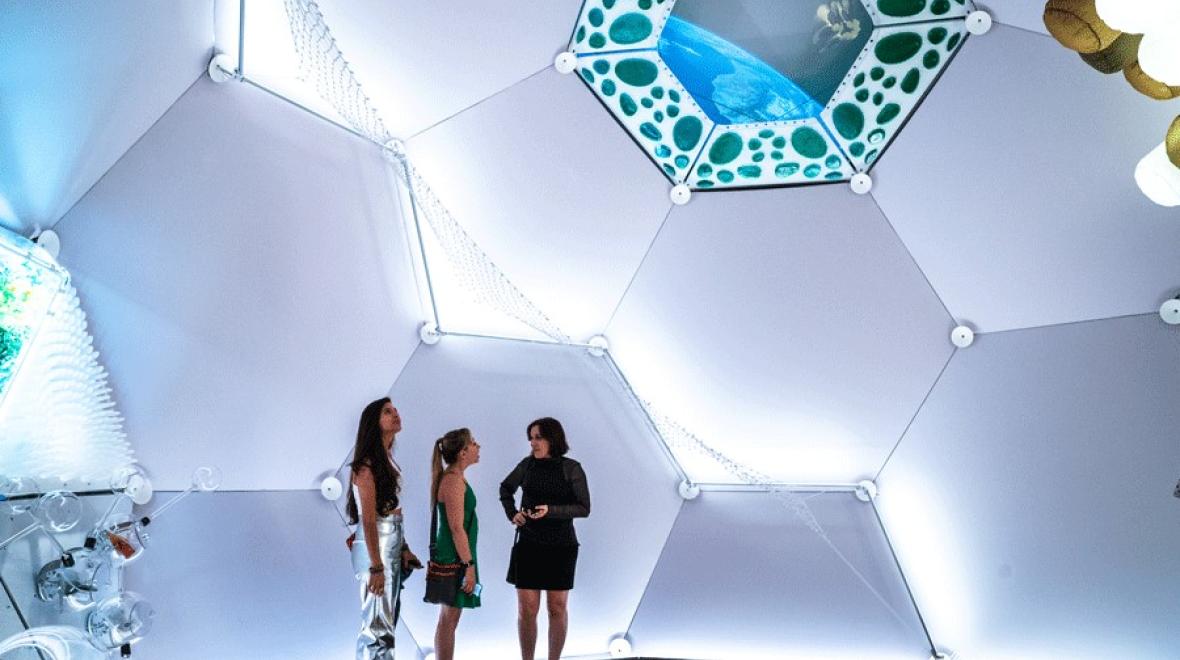
Photo:
The TESSERAE Space Habitat Pavilion opens Sept. 28 at The Museum of Flight. Photo: Jimmy Day, courtesy Aurelia Institute
Watching my daughter’s obsession with airplanes, space shuttles and outer space grow, I knew there was only one place to take her: The Museum of Flight. Not only is it the largest independent, nonprofit air and space museum in the world, it also recently opened “Home Beyond Earth,” a new exhibit I knew we couldn’t miss.
“Home Beyond Earth” gives museum visitors a closer look at living in space. And this week, the exhibit expands with a life-size space station module.
‘Home Beyond Earth’ and living in space
When we stepped into the lobby of The Museum of Flight, our eyes were immediately drawn upward. A reproduction of Leonardo da Vinci’s Il Cigno, a winged machine, hangs overhead, in the company of a hot air balloon model and replicas of gliders from the early 1900s. Seeing these early methods of flight dot the path to an exhibit on living in space felt surreal. How far we have come!

Before entering the immersive, interactive “Home Beyond Earth” exhibit, we picked up our Passport to Space card, tapped it on the screen and created our personal avatar. Throughout our visit, we tapped the card at different waypoints and used it to make choices about our avatar’s life in space based on their personal interests and jobs. I read the different choices to my young daughter, and she loved tapping on the screen and exploring the visual effects. And as a bonus, we kept the card as a (free) souvenir of our visit.

The exhibit explores past, present and future space stations, with a focus on home, work and community. There are plenty of artifacts and models to look at up close.

Even with the interactive elements, this is a text-heavy exhibit. Though I had to do the reading throughout the exhibit for my young daughter, there were different videos and projections throughout to keep her attention.

Admittedly, my daughter found the table with buildable space station parts to be the most engaging. I loved seeing the different uniforms and nods to science fiction.

The ‘TESSERAE Space Habitat Pavilion’ expansion
On Sept. 28, “Home Beyond Earth” expands with the opening of the “TESSERAE Space Habitat Pavilion.” Visitors are invited to experience living in space by stepping inside a life-size space station module. Standing 20 feet high, this dome pavilion lets visitors imagine what it will be like to grow food, cook and eat together in zero gravity. It’s the first public TESSERAE exhibit.

TESSERAE — or Tessellated Electromagnetic Space Structures for the Exploration of Reconfigurable, Adaptive Environments — consists of electromagnetically connected hexagonal and pentagonal tiles that are packed flat for launch and can self-assemble in space. Sounds pretty futuristic, right? The modular, customizable design — created by Aurelia Institute — is intended to make living in space more comfortable.

While the “Home Beyond Earth” exhibit runs through Jan. 20, 2025, the TESSERAE space station module will only be open until Jan. 12, 2025.
More exhibits at The Museum of Flight
“Home Beyond Earth” and the “TESSERAE Space Habitat Pavilion” are temporary exhibits at The Museum of Flight, but there is plenty more to explore at the museum year-round. When we first got to the museum, we hardly made it past the front lawn, where my daughter stared in awe at the Lockheed 1049G Super Constellation, a giant, retired airplane restored to its original glory.

With the promise of more planes inside, we made it to the museum, through the “Home Beyond Earth” exhibit and deeper into the William E. Boeing Red Barn. More than a barn, this section of the museum is actually Boeing’s original manufacturing plant. Expect a history lesson on American aerospace efforts here, alongside Boeing artifacts and vintage photos.

We then headed over to the T.A. Wilson Great Gallery for even more history (and kid-friendly exploration!). More than 50 aircraft on display detail human flight and how those early days set the stage for space travel. Here you’ll find the museum’s flight simulator, a motion control ride that does 360-degree barrel rolls. While my daughter was not yet tall enough for the flight simulator, she loved all the other opportunities in the gallery to see, touch and experience different elements of aircraft, from walking under the inlet cowl of an engine to stepping inside an airplane cabin.

Tucked into the gallery is the Aerospace Education Center, which hosts weekend family workshops. On our visit, we were invited to imagine our own home beyond Earth by building paper space stations and rovers.

Upstairs, we found the Kids Flight Zone. While I am sure my daughter is a future history buff, right now her main interests are climbing, running and playing pretend. The Kids Flight Zone checked all those boxes for her.

To further stretch her imagination, we stepped into the museum’s air traffic control tower, an interactive exhibit with a view of the King County International Airport. My daughter went right to work, listening to recorded communications and watching for planes.

Between the Kids Flight Zone and tower, my daughter had gotten her wiggles out, so we headed to the J. Elroy McCaw Personal Courage Wing, a two-story gallery dedicated to fighter pilots in WWI and WWII. Fun fact: the WWI planes are on the second floor because they’re lighter!
While my young daughter didn’t quite have the patience for a show so close to naptime, I was tempted to stay for a storytelling presentation on women in aviation (the museum has different historic presentations every afternoon, Sunday–Friday, at 1 p.m.).

The Museum of Flight bridge and west campus
Once we had explored the museum’s east campus, we crossed the T. Evans Wyckoff Memorial Bridge. This bridge takes you to the west campus, where you’ll find the Aviation Pavilion, Charles Simonyi Space Gallery and the Kenneth H. Dahlberg Research Center, though my toddler was content to stand on the bridge and watch airplanes fly overhead and cars pass underneath (it’s the simple things!).

In the Aviation Pavilion, you’ll find both commercial and military aircraft, spanning from the 1930s to the present day. Consider yourself more of an astronaut? Walk aboard the Space Shuttle Trainer to see what it would be like.
And of course, for those who visit the museum because of its incredible depth of history and research (or who need help with an upcoming school project), the library and archives in the research center — and the 120,000 books and 4 million photographs inside — can be accessed by appointment.
There is so much to see at The Museum of Flight — and it’s just the right blend of educational and engaging — that I know we will be back.
If you go to The Museum of Flight…Location: The Museum of Flight is located at 9404 East Marginal Way S. in Seattle. Hours: The Museum of Flight is open daily, 10 a.m.–5 p.m. Cost: Tickets can be purchased ahead of time online or in-person at the museum. When purchased online, tickets are $26 for adults; $22 for seniors ages 65 and older; $18 for children ages 5–17; and free to children ages 4 and younger. Discounts are available for military personnel, veterans, AAA members and Boeing employees. Visitors can also purchase a return trip ticket during your visit, allowing you to come back and visit within seven days of your original admission purchase at a discounted rate. Admission is free on the first Thursday of every month after 5 p.m. Parking: Parking is free, and there are plenty of spots in the museum’s parking lot. Food and dining options: The museum’s cafe is open daily, 10 a.m.–5 p.m., with plenty of kid-friendly options like macaroni and cheese, PB&J and snacks. If you plan to bring food, there is a small bag lunch area near the Kids Flight Zone. Outdoor picnic tables are also available for guest use. Additional info: Pick up an exploration guide at the admission desk (or print one out at home ahead of time) for extra fun throughout the museum. Tip: Bring a pencil so you can write down your findings on the printouts. More museums near Seattle to explore: |











